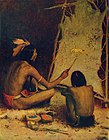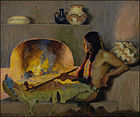Taos Society of Artists
The Taos Society of Artists was an organization of visual arts founded in Taos, New Mexico in 1915; it disbanded in 1927. The Society was essentially a commercial cooperative, as opposed to a stylistic collective, and its foundation contributed to the development of the tiny Taos art colony into an international art center.
Beginning
Joseph Henry Sharp, who decided to make painting of Native Americans his life work, visited Taos on a trip through New Mexico in 1893.[1] While there he became enchanted with the people of the Taos Pueblo and the landscape,[2] an interest he shared with Ernest Blumenschein when they were studying art in Paris.[1][2] Having heard of the degree to which Sharp was interested in painting the western United States, and the Indian pueblo of Taos in particular, Blumenschein came to Taos with fellow artist Bert Phillips in 1898. Planning only to visit Taos, they became enamored by the Taos valley and its people that they decided to stay. This was the beginning of the Taos art colony.[3]
Blumenschein described his first sights of Taos, "The month was September, and the fertile valley a beautiful sight, and inspiration for those who ply the brush for happiness. The primitive people of this out-of-the-way region were harvesting their crops by sunlight and by moonlight. Brown people they were, both Mexicans and Indians, happy people with happy children, in a garden spot protected by mountains." More compelling were the people. Native Americans had lived for centuries in the pueblo just outside the village of Taos. There a peace-loving, democratic society has maintained, and continues to maintain, its history, culture, dress and way of life over centuries.[4]
Ernest Blumenschein returned to New York for a time while Phillips stayed behind. Blumenschein kept up correspondence with Phillips and discussed setting up an artist colony in Taos. Blumenschein also wrote other artists in New York and Paris of Taos about the "beauty and artistic promise of northern New Mexico."[1]
By 1915 Joseph Henry Sharp, E. Irving Couse, Oscar E. Berninghaus and W. Herbert Dunton came to Taos and with Ernest Blumenschein and Bert Phillips they formed the Taos Society of Artists. The six founding members were known as the "Taos Six". E. Irving Couse was the Society's first president.[3]
Their work, defined the first several decades of the Taos art colony, was distinguished by: Native Americans in traditional clothing, area Hispanics and Anglo-Americans and landscapes.[1]
They sent travelling exhibits of their work across the United States. Initial critical reaction of the works was that they were unrealistic and overdone: vivid colors, too emotionally evocative and strong vibrational quality. The artists questioned the critics veracity, since they had never been to the southwestern desert, nor the Taos Pueblo.[5]
-
E. Irving Couse, The Historian, 1902
-
E. Irving Couse, Lovers (Indian Love Song), 1905
-
Ernest L. Blumenschein, The Peacemaker (The Orator), 1913, Courtesy of the Anschutz Collection
-
E. Irving Couse, Contentment, 1918
-
E. Irving Couse, Smoke Ceremony, 1919
-
Ernest L. Blumenschein, Star Road and White Sun, 1920, Albuquerque Museum of Art and History, New Mexico
-
Joseph Henry Sharp, Making Sweet Grass Medicine, Blackfoot Ceremony, ca. 1920, Smithsonian American Art Museum, Washington, D.C.
-
Ernest L. Blumenschein, Superstition, 1921
-
William Herbert Dunton, The Horse Rustler, ca. 1915
Structure and membership
Member artists had to have worked in Taos for three consecutive years, shown an interest and aptitude for painting Native Americans and have shown in reputable galleries or New York salons (ongoing art exhibits). The primary reason for the requirements was to ensure that the artists were well-intentioned and capable of capturing the character and spirit of the people.[6]
Later members included Julius Rolshoven, E. Martin Hennings, Catharine C. Critcher (the only female member [7]), Kenneth Adams, Walter Ufer, and Victor Higgins.[8]
-
Walter Ufer, The Listeners, 1920, Philbrook Museum in Tulsa, Oklahoma
-
Victor Higgins, Indian Girl with Parrot and Hoop, ca. 1920, Indianapolis Museum of Art
-
Julius Rolshoven, The Sun, Tesuque Pueblo Indian, 1921
Associate and honorary members
Some artists from Santa Fe, another developing arts center, were included as Associate members: Robert Henri, Albert L. Groll, Randall Davey, B.J.O. Nordfeldt, Gustave Baumann, Albert Groll, Birger Sandzén,[8] and John Sloan.[9]
Honorary memberships were extended to men who helped create a museum infrastructure in New Mexico: Edgar L. Hewett, the director of the Museum of New Mexico; and Frank Springer, whose donations helped to build the Museum of New Mexico’s Fine Arts Museum in Santa Fe.[9]
War work
During World War I, the Taos society artists served on United War Work Committees, designed posters and exhibited canvases at Red Cross bazars. Most notably they created "range-finder paintings", 50 by 100 foot landscapes of Belgium and France used as military teaching tools.[10] Several of these paintings were exhibited in the 1918 Taos Society of Artists' annual exhibition held at the Museum of New Mexico[11]
Depression
The depression was the precipitating factor for the dissolution of the Taos Society of Artists. Taos was devastated by the depression and the artist's patrons were not spending money on art during that time. Victor Higgins the most financially devastated by the Depression made two of his most important paintings during that time, Winter Funeral heralded by the New York press, and Sleeping Nude similarly praised by the Chicago Herald Examiner writer Inez Cunningham. Cunningham likened Higgins to a phoenix rising out of the ashes, "what heights of intellectual and emotional fire. He is one of those fortunate few who flower in maturity."[8]
Influence
The "Taos Six" applied academic technique to native themes to produce a uniquely American school of painting. Each artist's style was unique, though cross influence can certainly be noted as can strong elements of their European Academic artistic training. Aside from the inspiration of their environment, one quality early Taos art colony paintings share is their vibrant palette of colors - not a common sight when paired with more traditional representational images and application of paint. Today, these artists are recognized for their contribution to artistic development and their scenes of Taos locales grace the walls of many museums.[9]
See also
- Eanger Irving Couse House and Studio—Joseph Henry Sharp Studios
- Ernest L. Blumenschein House
- Los Cinco Pintores, contemporaneous artist collective in Santa Fe
References
- ^ a b c d "Taos Society of Artists". Collections. Harwood Museum of Art. Retrieved 2011-05-29.
- ^ a b James (1920), p. 373
- ^ a b Bleiler, L; Society of the Muse of the Southwest (2011). Taos. Images of America. Charleston: Arcadia Publishing. p. 75. ISBN 978-0-7385-7959-7.
{{cite book}}: CS1 maint: multiple names: authors list (link) - ^ James (1920), pp. 375-376
- ^ James (1020), pp. 377-378
- ^ James (1920), pp. 376-377
- ^ http://addisonrowe.com/Gallery_Artists/Catherine_Carter_Critcher/
- ^ a b c "About". Taos Art Museum. Retrieved 2011-05-29.
- ^ a b c Whaley, Bill; Stiny, Andy. "Reconsidering Art in Taos; Bert Phillips" in Taos Horse Fly, February 17, 2009.
- ^ RINDGE, FRED HAMILTON (September 1926). "TAOS—A UNIQUE COLONY OF ARTISTS". The American Magazine of Art. 17 (9): 452. Retrieved 20 April 2016.
- ^ White, Robert R. (1998). The Taos Society of Artists. Albuquerque: University of New Mexico. p. 111. ISBN 0826319467.
Bibliography
- James, G. (1920). New Mexico: The Land of the Delight Makers. Boston: The Page Company.
Further reading
- Broder, Patricia Janis (1980). Taos, a Painter's Dream. Boston: New York Graphic Society.
- Peters, Gerald III, ed. (1998). The Taos Society of Artists: Masters and Masterworks. Gerald Peters Gallery. ISBN 0-935037-78-0.
- Schimmel, Julie; White, Robert R. (1994). Bert Geer Phillips and the Taos Art Colony (1st ed.). University of New Mexico Press. ISBN 0-8263-1444-9.
- Shipp, Steve (1996). American Art Colonies, 1850-1930: A Historical Guide to America's Original Art Colonies and Their Artists. Greenwood Press. ISBN 0-313-29619-7.
External links
- Taos Society of Artists: 1915 - 1927, Koshare Indian Museum
- Catherine Jansen, "The Taos Society of Artists", bibliography, 1999, Eiteljorg Museum of American Indians and Western Art
- Taos as an Art Colony: From the Taos Society of Artists to the Present, Taos Unlimited
- Taos Pre 1940, Ask Art














